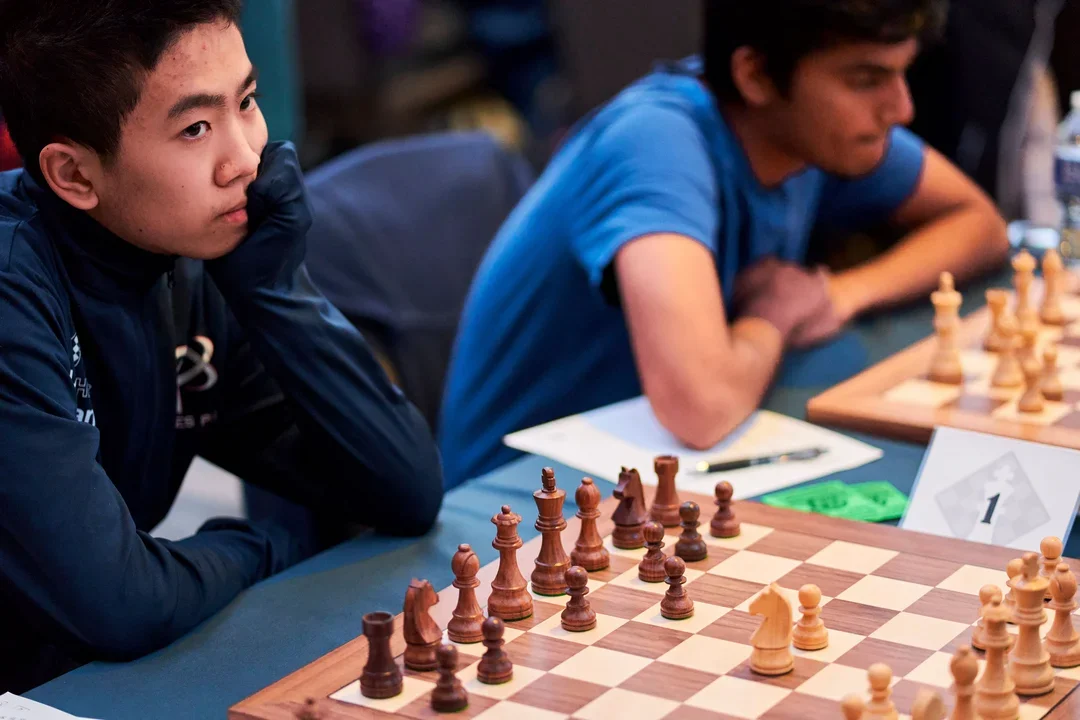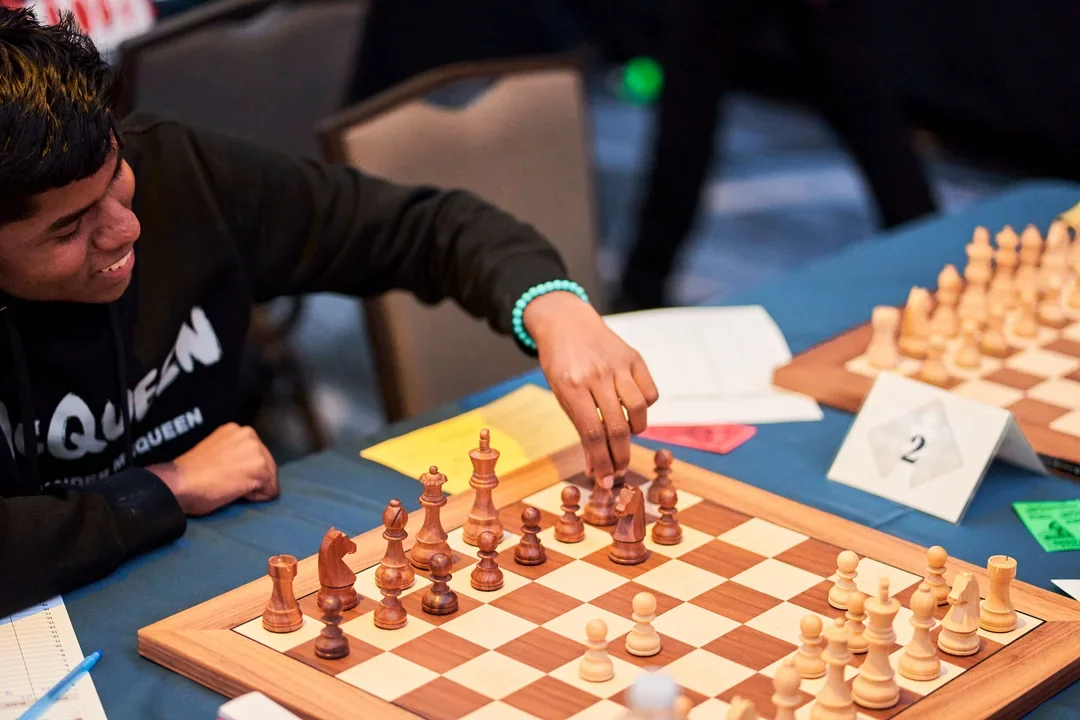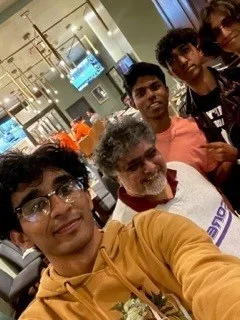

For this story, we (Jason and Sharvesh) asked if we could collaborate to share our experiences at the National High School (K-12) Championships with each other and with the readership of Chess Life Online.
Several of our games have already been covered here during the daily recaps of the event. So, our editor (JJ Lang) suggested we annotate each other's games, as well as significant games from the "under" sections, as to give new insights into how strong players think about each other's games, as well.
Annotating each other's games proved to be an insightful experience, allowing us to compare different perspectives on the same game and converse over what we would have done if we were in each other's place. It was interesting to see how our decision-making processes were distinct yet fitting to our playing styles, and we learned about the aspects of our play that make us unique. Hopefully you will enjoy learning from this, too.
And They're Off!
A record-breaking 1745 players flocked to the 2023 National High School Championship, held in the Washington Hilton hotel in Washington DC from March 31 through April 2. This was a tremendous increase over the previous year, when only 1060 players attended, and it was also higher than the previous record of 1713 players in 2019.
This tournament attracted players from all around the country, including participants from 38 states: a true conglomeration of chess talent and potential across the United States. The tournament also boasted more than 600 teams across the nation, each seeking to bring glory back to their school.
The atmosphere of the National High School Championships always makes it an interesting event to play in. High schoolers (and of course some younger individuals) battle it out to the top in an intense environment where every player is focused, ready, and sharp. It is a captivating sight to behold.
The thing about these national events that makes them so difficult to play — and even more difficult to win — is the amount of underrated players. Many high schoolers play in their local school leagues but don’t get the opportunity to play in rated events, causing their ratings to be deceptively low. Then, huge schools come with dedicated coaches after preparing for weeks and weeks just for this event, meaning these players are probably also underrated, even if they play a lot of rated events. In other words, no opponent should be taken lightly.
In such tournaments, upsets are to be expected, adding to the dynamic nature of these events. I (Jason) still remember the first time I played this event in 2015, when I was rated around 2000. In that tournament I lost many rating points to lower-rated players: scholastic tournaments are hard to play indeed!
The tournament consisted of six sections: Championship, Under 1900, Under 1600, Under 1200, Under 800, and Unrated. The top five sections took place in the International Ballroom, a faintly lit yet strangely entrancing site, while the Unrated section was played in the Crystal Ballroom.
Championship
The championship section featured an especially strong field this year with two International Masters (Arthur Guo and Maximillian Lu) and four IM-elects (Nico Chasin, Sandeep Sethuraman, Tugstumur Yesentumur, and one of your authors, Jason Wang).
Last year, seven players tied for first, including Guo and Chasin. An additional three of the reigning co-champions from 2022 (FM Gus Huston, FM Vishnu Vanapali, and Advaith Karthik) returned this year to defend their title as well.
Entering the first round, the nostalgia of scholastic chess events returned: parents waving goodbye, kids squirming to find their board, and TDs ushering parents out of the room. And with the shake of hands, the tournament had begun.
Despite the many underrated players in this event, the top ten players on DGT boards achieved an impressive 9½/10, 10/10, and 9½/10 points in the first three rounds. These results, however, did not reflect the true story of the difficulties faced by these players. Although the top players were paired against players rated more than 300 points lower than them, many of these games were extremely close. Indeed, both of your authors faced losing positions and risked having their chances to win the tournament put to an early end. But we assure you we were not the only ones who got lucky!
In round one, Jason survived a scary attack and managed to come out on top in a crazy time-scramble.
The second round was quite smooth for the first ten boards, as no higher-rated player was seriously in danger of losing. The perfection achieved on these top boards was an admirable feat: for one higher-rated player to win his or her game is to be expected, but for all of them to win was impressive, especially in a tournament such as this one where so many players are underrated.
In the third round, however, the higher-rated players struggled much more. IM Arthur Guo managed to beat Adhvaith Rajanish on the first board from a worse position in an intense time scramble.
Sharvesh was also in hot water after getting an unpleasant position out of the opening, but managed to complicate the position and win his game.
The fourth round was the first round where many higher-rated players dropped half-points, as five of the ten top games were drawn. This made sense, as the rating gap between players dropped to about 200 points. At the close of this round, only six players remained with a perfect score.
Round five was crucial, as by the end of this round the leaders knew who was really in contention for the title. Again, Jason survived a brutal attack, in which both players overlooked a brilliant queen sacrifice that could have ended the game. By walking the tightropes and winning this game, however, Jason was one of the two players left with a perfect score.
The other perfect score after five rounds was FM Gus Huston, who had just dismantled the top-seeded Guo in a battle of 2022 co-champions. Huston displayed superb knowledge of the Alapin Sicilian and found some nice tactics against Guo’s uncastled king to win the game convincingly.
After the fifth round, I (Sharvesh) had to get my mind off the awful quality chess I was playing. First, I ate dinner with my friends, but with the restaurants on Uber Eats all showing over a delivery window of over 40 minutes, we had to resort to the hotel restaurant. Just as my friends and I were talking about how lucky we had been during this tournament, however, FM Sunil Weeramantry — a renowned coach and member of the US Chess Scholastic Committee — walked by and gave us an amazing conversation. He told us some funny stories: it was just the energy I needed to get back in the right mindset, and I am certain this helped me perform and become a co-champion the next day.

In the sixth round, I (Jason) faced off against Gus on the first board. Incidentally, this was not the first or even second time I was playing him in a scholastic event. Looking back through the archives, I saw that I had played Gus in both the 2013(!) National Grade Level in second grade and the 2017 K-6 Super Nationals (in both events, I was either a co-champion or overall champion: an interesting phenomenon indeed). I was excited about this rematch and spent the night preparing the Catalan, which was an opening I had never played before. I am happy to say that it worked about well for me: I won the game with reasonable confidence, despite a few bumps in the road.
Finally, we entered the final round. I (Jason) was paired against FM Nico Chasin, who had just beaten Nicolas Ladan in a grueling four-hour game. I achieved a winning position but offered a draw to guarantee my position as at least co-champion.
Sharvesh managed to climb his way back to a win after getting a worse position out of the opening against IM-elect Sandeep Sethuraman, claiming his spot alongside me.
In the end, your two authors won the tournament with 6½/7, with Jason snatching the slightly higher tiebreaks. The Dalton School chess team, located in New York and headed by GM Alexandr Lenderman, took the title of first-place team with 22 points, a full two points ahead of Virginia’s Thomas Jefferson High School.
Despite the struggles and occasional losing positions in our games, we managed to wind our way through and come out on top. Our experience and confidence definitely helped us on our journey to victory.
Under 1900
In the Under 1900 section, Naren Pullela was the sole leader after six rounds after upsetting top seed WCM Chance Nguyen. After Nguyen failed to find the accurate line in her attack, Pullela navigated his way through the complications in the Najdorf and was able to crawl back and win; this win put him on 5½/6, needing a draw to tie for first.
Going into round seven, only two people could catch Pullela: Harper Wallace and Pullela's previous opponent Nguyen. In a theoretical battle in the Grunfeld, Pullela got the upper hand in the middle game but decided to go for a perpetual check instead of recapturing a rook to guarantee at least a share of the top spot. However, he missed one way Wallace could eschew the perpetual and lost the game.
Meanwhile, Nguyen won her game on the second board, tying Wallace for the first-place spot. After the dust settled, Nguyen emerged on top with the higher tiebreaks.
Under 1600
The Under 1600 section was a closely fought battle for the crown. After six rounds, both Manuel Alvare and Simon Kravitz remained with perfect scores.
Alvare’s potential to win this tournament was seen in his fifth-round victory against Jorge Cavazos, where he demonstrated his positional understanding of the Italian Game.
After a relatively peaceful draw between Alvare and Kravitz in the final round, both finished atop the standings, with Alvare claiming the higher tiebreaks.
Under 1200, Under 800, Unrated
In the Under 1200 section, Zachary Nowel came out on top with an impressive 7/7 performance. His aggressive playing style, essaying the Dutch with the black pieces, proved difficult for his opponents to counter. His last few rounds, featuring domination on both the positional and tactical fronts, left no question as to whether he was the deserving winner.
Here is his game in the last round, where he stormed the white king, breaking up the defense and winning the game.
Last but not least, the final two sections both featured perfect scores. Andrew Wormenhoven battled his way to a perfect 7/7 in the Under 800 section, while Mohit Maringanti played in an impressively uncompromising style to achieve the same score in the Unrated section.
And with that, the games of the 2023 National High School Championships came to a close. The closing ceremony saw three winners and three pairs of co-winners crowned, yet after the ceremony came the bittersweet time of departure. Looking back, scholastic tournaments are always fun and rewarding -- hard to play, yes, but still invigorating to see so many chess faces together in one room, all with the same purpose: to win.
Categories
Archives
- December 2025 (26)
- November 2025 (29)
- October 2025 (39)
- September 2025 (27)
- August 2025 (29)
- July 2025 (43)
- June 2025 (25)
- May 2025 (24)
- April 2025 (29)
- March 2025 (29)
- February 2025 (20)
- January 2025 (24)
- December 2024 (34)
- November 2024 (18)
- October 2024 (35)
- September 2024 (23)
- August 2024 (27)
- July 2024 (44)
- June 2024 (27)
- May 2024 (31)
- April 2024 (51)
- March 2024 (34)
- February 2024 (25)
- January 2024 (26)
- December 2023 (29)
- November 2023 (26)
- October 2023 (37)
- September 2023 (27)
- August 2023 (37)
- July 2023 (47)
- June 2023 (33)
- May 2023 (37)
- April 2023 (45)
- March 2023 (37)
- February 2023 (28)
- January 2023 (31)
- December 2022 (23)
- November 2022 (32)
- October 2022 (31)
- September 2022 (19)
- August 2022 (39)
- July 2022 (32)
- June 2022 (35)
- May 2022 (21)
- April 2022 (31)
- March 2022 (33)
- February 2022 (21)
- January 2022 (27)
- December 2021 (36)
- November 2021 (34)
- October 2021 (25)
- September 2021 (25)
- August 2021 (41)
- July 2021 (36)
- June 2021 (29)
- May 2021 (29)
- April 2021 (31)
- March 2021 (33)
- February 2021 (28)
- January 2021 (29)
- December 2020 (38)
- November 2020 (40)
- October 2020 (41)
- September 2020 (35)
- August 2020 (38)
- July 2020 (36)
- June 2020 (46)
- May 2020 (42)
- April 2020 (37)
- March 2020 (60)
- February 2020 (38)
- January 2020 (45)
- December 2019 (34)
- November 2019 (35)
- October 2019 (42)
- September 2019 (45)
- August 2019 (56)
- July 2019 (44)
- June 2019 (35)
- May 2019 (40)
- April 2019 (48)
- March 2019 (61)
- February 2019 (39)
- January 2019 (30)
- December 2018 (29)
- November 2018 (51)
- October 2018 (45)
- September 2018 (29)
- August 2018 (49)
- July 2018 (35)
- June 2018 (31)
- May 2018 (39)
- April 2018 (31)
- March 2018 (26)
- February 2018 (33)
- January 2018 (30)
- December 2017 (26)
- November 2017 (24)
- October 2017 (30)
- September 2017 (30)
- August 2017 (31)
- July 2017 (28)
- June 2017 (32)
- May 2017 (26)
- April 2017 (37)
- March 2017 (28)
- February 2017 (30)
- January 2017 (27)
- December 2016 (29)
- November 2016 (24)
- October 2016 (32)
- September 2016 (31)
- August 2016 (27)
- July 2016 (24)
- June 2016 (26)
- May 2016 (19)
- April 2016 (30)
- March 2016 (36)
- February 2016 (28)
- January 2016 (32)
- December 2015 (26)
- November 2015 (23)
- October 2015 (16)
- September 2015 (28)
- August 2015 (28)
- July 2015 (6)
- June 2015 (1)
- May 2015 (2)
- April 2015 (1)
- February 2015 (3)
- January 2015 (1)
- December 2014 (1)
- July 2010 (1)
- October 1991 (1)
- August 1989 (1)
- January 1988 (1)
- December 1983 (1)







